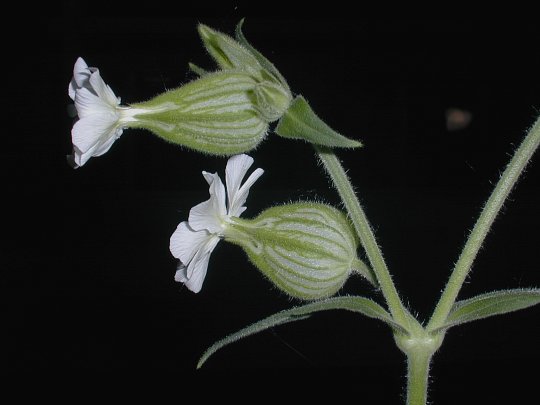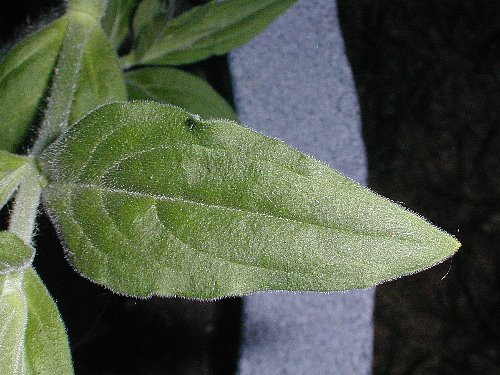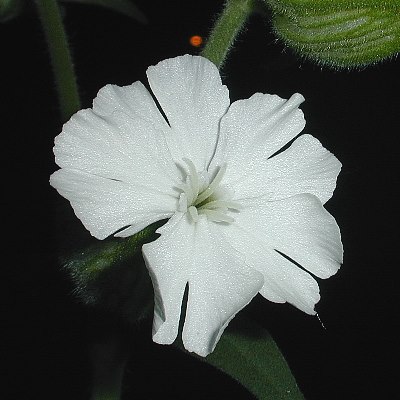Description: This dioecious plant is an annual, biennial, or short-lived perennial about 2' tall, branching occasionally and more or less erect. The light green stems are terete (round in cross-section) and covered with fine hairs. The opposite leaves are up to 4" long and 2¼" across. They are light green to medium green, ovate-lanceolate, more or less sessile, smooth along the margins, and finely pubescent.

The upper stems terminate in clusters of one or more night-blooming flowers. Each flower is about ¾–1" across when fully open, consisting of 5 white petals that are partially cleft, a light green calyx about ¾-1" long, and either male or female reproductive organs. The finely pubescent calyx has several dark green or purple veins spanning its length. The petals are obovate-obcordate in shape. At the base of each petal, there is a pair of minute claws. Each male flower has 10 white stamens and a cylindrical-ovoid calyx with about 10 major veins. Each female flower has 5 white styles and an ovoid calyx with about 20 major veins. The calyx of the female flowers has a more inflated appearance than the calyx of the male flowers. Sometimes female flowers have 4 or 6 styles. The blooming period occurs during the summer and lasts about 1-2 months. The flowers bloom intermittently at night, rather than simultaneously; they are fragrant. On female plants, each flower is replaced by an ovoid seed capsule up to 1" long that is open at the top. Along its upper rim, there are 5 small teeth that are deeply cleft – they have the appearance of 5 pairs of teeth. These cleft teeth are either erect or spreading, rather than sharply recurved. Each seed capsule contains numerous grayish brown seeds that are reniform with a pebbly-granular surface. The root system consists of a fleshy branching taproot. This plant spreads by reseeding itself.

Cultivation:
Full or
partial sun, mesic conditions, and a fertile loamy soil are preferred.
This plant develops quickly from seed and can become 3' tall in fertile
soil, although it is usually smaller.
Range & Habitat:
The non-native Evening Campion is a common plant in most areas of
central and northern Illinois, but rather uncommon in southern Illinois
(see Distribution
Map). It was introduced into North America from Europe.
Habitats include edges of fields, areas along railroads and roadsides,
gardens and nursery plots, weedy meadows, and miscellaneous waste
areas. This plant prefers disturbed areas, particularly where the soil
has been recently cultivated. It is not invasive of natural areas to
any significant degree.
Faunal Associations:
The nectar of the flowers attracts moths, especially Sphinx moths
(Sphingidae). The foliage, buds, and/or flowers are eaten by the adults
and larvae of Cassida
azurea (Neon Tortoise Beetle) and Cassida flaveola
(Pale Tortoise Beetle). Both of these beetles are native to Europe.
Members of the Pink family are not preferred sources of food to
mammalian herbivores because their foliage contains varying amounts of
saponins, which can irritate the gastrointestinal tract and damage the
red blood cells.

Photographic
Location:
The plant was growing in a large flower pot at the webmaster's
apartment in Urbana, Illinois. The photographed plant is
female.
Comments:
The flowers of Evening Campion (Silene
latifolia) are lovely when illuminated by a night
light. Among the Silene spp. occurring in Illinois,
Evening Campion is unique in having plants with either all male or all
female flowers. The female flowers usually have 5 styles, whereas most
other Silene spp. have 3 styles. The seed capsule
has 5 cleft teeth that resemble 5 pairs of teeth (or 10 teeth), whereas
the seed capsules of other Silene spp. usually have
5 teeth that aren't cleft. These two sets of features are useful in
distinguishing Evening Campion from another introduced species, Silene
noctiflora (Night-Flowering Campion), which has a similar
appearance. Unfortunately, Evening Campion has been the subject of
several taxonomic revisions, acquiring several scientific names in the
process, including Melandrium album, Lychnis alba, Silene
alba, Silene pratense, Silene
pratensis, and Silene latifolia. Another
common name for this species is White Campion.